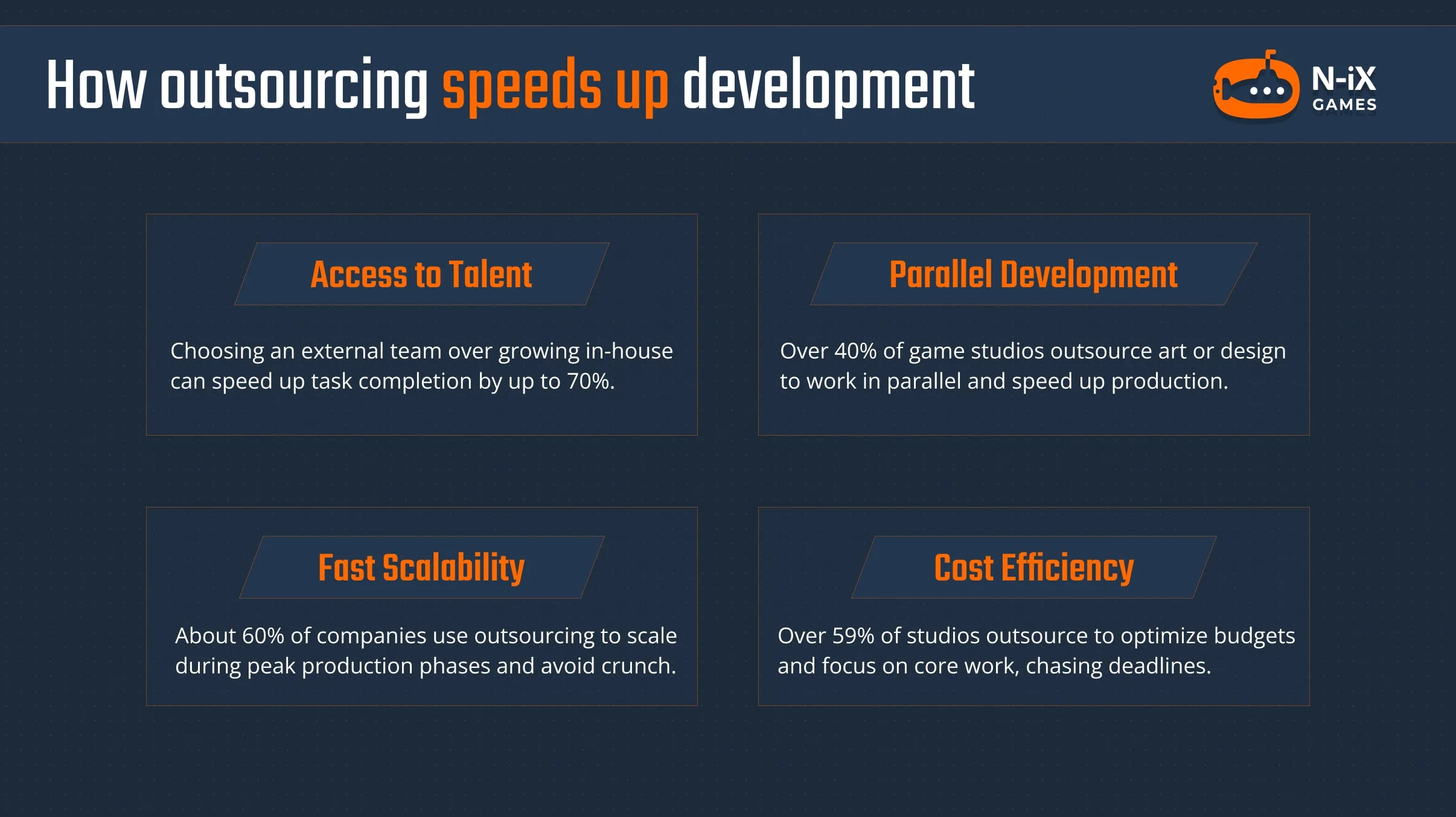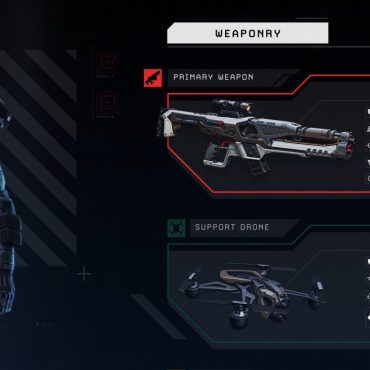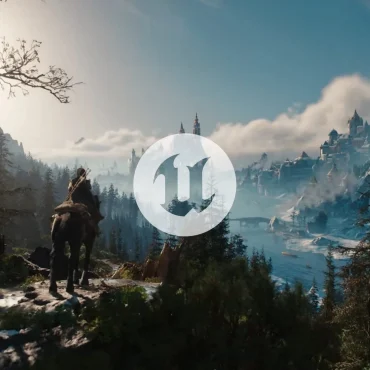In the ultra-competitive mobile gaming market, studios often have less than a year to turn an idea into a live game. How do successful teams meet these tight deadlines and deliver quality? They often don’t do it alone — many leverage outsourcing and mobile game services to accelerate production without compromising creativity or quality. In this post, we’ll explore how outsourcing helps develop mobile games faster, the different outsourcing models (from art-only to full-cycle), and real-world examples from our own experience.
Why the need for speed in mobile game development?
Mobile gamers are impatient, and new content and updates are expected at a rapid clip. Unlike AAA console titles that can brew for years, mobile games typically take only a few months to a year to develop. Smaller scope and 2D/3D mobile-friendly art mean a project might go from concept to launch in, say, 6–12 months. This fast timeline is both an opportunity and a challenge.
Mobile games often have simpler mechanics and shorter loops than PC/console games, letting mobile game developers move quickly. The process usually starts with a clear Game Design Document (GDD, the blueprint of the game’s design), then rapidly producing a vertical slice (a small playable demo with all core features) to ensure the vision is solid. From there, it’s a sprint: crafting the core loop (the main gameplay cycle that keeps players coming back) and churning out assets, levels, and features in quick succession. Every week counts, and delays can mean missing a market trend or being outpaced by a competitor.
However, even a 6-month project can feel intense when your in-house team is small or juggling multiple titles. By collaborating with external experts, studios can compress development timelines and hit those tight launch dates. Let’s look at exactly how mobile game outsourcing makes this possible.
How mobile game outsourcing accelerates projects
Outsourcing isn’t about cutting corners — it’s about gaining speed and bandwidth by bringing in the right help at the right time. Here are some key ways that mobile game outsourcing helps teams move faster:

Instant access to specialized talent
Instead of spending months hiring or training staff, you can tap into an external pool of experienced mobile game developers on demand. These professionals (Unity developers, 2D/3D artists, animators, etc.) have done it all before, so they hit the ground running. By hiring an external team instead of ramping up in-house, tasks can be completed in up to 70% less time. Outsourcing can bring veterans onto your project overnight.
Parallel development streams
Outsourcing lets you work on multiple parts of the game simultaneously. While your core team focuses on gameplay and the all-important core loop, an external art team can build characters and environments at the same time, or perhaps another partner handles UI or QA. This parallel development approach can significantly reduce the overall timeline. According to the International Game Developers Association (IGDA) research, over 40% of game studios outsource art or design tasks to external teams. It’s a common way to speed up production by having different specialists tackle work in tandem.
Scalability on demand
Need to add 5 more artists or two extra Unity programmers yesterday? A hired mobile game outsourcing company makes it possible to scale your team fast without the usual in-house HR overhead. You can quickly ramp up for a content push or a crunch period, then scale down after release. According to industry surveys, about 60% of companies use outsourcing to scale during peak production phases. This flexibility keeps your project on track when deadlines loom, all without long-term staffing commitments.
Focus on core creativity
By offloading time-consuming tasks (like asset production) to an external team, your in-house mobile game developers can concentrate on the core vision and gameplay. You’re free to iterate on what makes the game fun — the gameplay, the mechanics, the balance — while your mobile game outsourcing company handles everything else in the background. This division of labor not only speeds things up but can also result in a better game (because your team isn’t spread so thin).
Cost-time efficiency
Cost efficiency in mobile game outsourcing isn’t just about paying less — it’s about spending smarter in a way that fuels speed. Building a full in-house team for a project that might last under a year means onboarding, training, and carrying salaries long after the launch. An outsourcing partner lets you skip those fixed costs and tap into ready-to-go specialists who are productive from day one. This lean approach frees budget for critical accelerators that keep timelines tight, like feature polish, QA, etc.. By avoiding overhead and funneling resources directly into high-impact work, studios can be sure that every dollar spent pushes the project toward a timely release.
Faster time-to-market:
All of the above benefits boil down to one thing, getting to launch sooner. By adding manpower and expertise, outsourcing compresses schedules. And importantly, a good mobile game outsourcing company will ensure quality control through their own QA and art review processes. Many outsourcing providers stake their reputation on delivering high-quality work, so they have strict internal checks to meet your standards. The result: you save time and maintain quality, hitting launch day with confidence.
Ways to outsource mobile game development
Not all outsourcing is all-or-nothing. In fact, there are multiple engagement models depending on your needs. Whether you want a little help or a full development team, there’s an outsourcing approach that fits. Here are the three main models to consider when you outsource mobile game development:
- Art Production Outsourcing: In this model, you keep core development in-house but outsource art production — things like character models, animations, UI graphics, or environment art. Art is often one of the most time-consuming aspects of game dev, so partnering with an art team can drastically accelerate production. For example, your in-house game designers can continue refining levels and the core loop while outsourced artists deliver assets in parallel. The key here is tight alignment on style — you’ll provide style guides, concept art, or samples to ensure the external art matches your vision. Many studios choose this model when they have strong engineering/design teams but need extra creative hands to produce large volumes of art quickly. If you are interested about this model and need some guidance, see our step-by-step guide on how to outsource game art.
- Co-Development (Partial Outsourcing): In a co-development scenario, an external team works alongside your team on substantial parts of the project. You might outsource specific programming tasks (say, an online multiplayer module or porting the game to Android) or content creation (like level design, writing narrative content, or creating DLC). Co-development is a true partnership: you and the mobile game outsourcing company share responsibilities, often integrating their mobile game developers, artists, or designers into your workflow. This model is great for tackling areas where your team lacks expertise or simply for dividing and conquering a huge project. The upside is speed and expertise, but it requires close coordination so that both teams stay in sync. Regular check-ins, shared project management tools, and clear documentation (e.g. an updated GDD and asset list) are essential to make co-dev seamless.

- Full-Cycle Development: “Bring the whole game to life for us.” Here, you entrust an outsourcing company with building the game from A to Z — covering all development stages from initial design and prototyping to final polish and launch. Does that mean you lose control? Not at all. In a good full-cycle arrangement, you as the IP owner still call the shots on creative direction — you define the vision, gameplay concept, and key design pillars — but the external team executes the implementation. Think of it as having a dedicated satellite studio working on your game. This model works well if you have a strong concept or vision but lack the internal team to build it within the desired timeframe. A full-cycle mobile game outsourcing company will assemble all the needed roles (producers, artists, programmers, QA, etc.) and manage the project daily, while you get progress updates and give feedback to steer the creative decisions. The benefit is maximum acceleration: a full, experienced dev team spinning up quickly to make your game a reality. Many studios choose this route to meet aggressive timelines or to work on multiple games at once, all while maintaining creative oversight.
Each model has its benefits. You might start by outsourcing one aspect (like art), and later scale up to co-development or full-cycle as trust builds. The common thread is that outsourcing — in any form — augments your capabilities so you can develop a mobile game faster and usually cheaper than doing it alone.
Developing multiple mobile games in parallel
Let’s step away from theory and look at how outsourcing has tangibly sped up mobile game projects:
Netflix Stories

When Netflix set out to create Netflix Stories, a series of narrative mobile games based on hit shows, they faced a challenge: develop multiple story-driven mobile games simultaneously and get each one out in about a year timeline. To achieve this, N-iX Games assembled dedicated teams to handle everything from art and animation to Unity development and QA, effectively acting as an extension of Netflix’s studio. This allowed several titles to be in production at once without overwhelming Netflix’s internal game development resources.
Over the partnership, N-iX Games scaled up to six teams (60+ professionals) working in parallel, developing up to five mobile games at a time. Thanks to this outsourcing collaboration, the average development cycle for each game was only 10–14 months from script to release — roughly a year or less per title, which is incredibly fast for content-rich narrative games. Netflix’s internal creative team provided the scripts and IP direction (so they retained creative control), while the N-iX teams handled implementation and production under agile sprints.
The results: in 2023–2025, N-iX contributed to 15 Netflix Stories titles, including releases like Love Is Blind: NYC and Outer Banks, each packed with dozens of hours of content delivered on time. The Netflix Stories app gained nearly 7 million downloads, becoming one of Netflix’s most successful mobile gaming ventures.
This was possible because full-cycle outsourcing gave Netflix the bandwidth and speed to run multiple game projects concurrently. They hit their deadlines, maintained quality (Netflix praised N-iX’s art as “among the best” in the initiative), and kept fans engaged with a steady stream of new mobile games.
Wrapping up
In the fast-paced world of mobile gaming, speed is often the deciding factor between success and being left behind. Mobile game outsourcing has emerged as a powerful strategy to boost that speed. By bringing in external talent — whether for a specific piece of the puzzle or to build an entire game — studios can accelerate development timelines, scale effortlessly, and access top-notch expertise.
With clear communication and management, outsourcing allows you to outsource mobile game development on your terms, keeping your creative vision front and center while the heavy lifting happens in parallel.
Mobile game development with N-iX Games
If you’re looking to get your next project into players’ hands faster, N-iX Games is here to help. We’ve been the co-creators behind fast-track projects and full-cycle games, and we understand the unique challenges of mobile timelines. Drop us a line and we’ll discuss how to turn your tight schedule into a success story.




